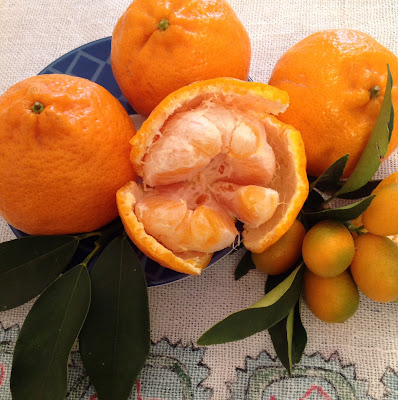Imperial mandarins are an Australian citrus. I was
surprised to discover this when I started reading about Imperial mandarins
online the other day. It’s winter in the Southern Hemisphere, and I’ve been
tucking into Imperials lately because they are a winter joy: sweet, juicy, easy
to peel, and rich in vitamin C and antioxidants. Finding out that they first appeared
here in Sydney, in about 1890, was the icing on the cake.
My online research said that the Imperial mandarin
appeared as a chance hybrid of the Mediterranean or the Willowleaf mandarin with
another, possibly Emperor. Plainly it was a hit in 1890, and has been popular
ever since. Imperial is an early maturing fruit, the first mandarin in my local
fruit shop just when I’m trying to avoid winter colds.
These days Imperials are widely grown, many in
central Queensland, where orchardist Bindi Pressler and her husband Craig have
their 2PH farms. Like farmers everywhere, Bindi and Craig have had difficulties
to face – I take my hat off to farmers around the world for their courage and
resilience. Craig and Bindi had to replant 1600 acres of citrus trees in 2007,
after citrus canker devastated their farm in 2005. Then in 2011, the central
Queensland floods arrived to set them back again. Good luck for the future,
Bindi and Craig.
Further south in the Sunraysia district, near the
Murray River, is Seven Fields, a 100% Australian family owned company that
grows, packs and markets excellent citrus fruit. David Stephens of Seven Fields
is a major grower of the Afourer mandarin. Also called the Nadorcott or W.
Murcott, the Afourer is said to have come from Morocco.
The origin of mandarins is interesting. They are
considered to be native to South-East Asia and the Philippines and grown
abundantly in Japan, southern China and India. I read that dried mandarin peel
is known in traditional Chinese medicine and in ayurvedic or traditional Indian
medicines. According to molecular studies, the mandarin, the citron, pomelo and
papeda were the ancestors of the commercial citrus varieties we know today.
And, I’m told, the mandarin is the only truly sweet fruit among them.
I read that two varieties of mandarin were taken
from Canton to England in 1805, and later adopted for cultivation around the
Mediterranean. Somewhere between 1840 and 1850, the Willowleaf or China
Mandarin was imported by an Italian consul to the consulate in New Orleans, and
carried from there to Florida and California.
My mandarin photo, above, also shows a few cumquats from our
garden. They grow abundantly and every year I make some cumquat marmalade using
a recipe from the Burke’s Backyard (former) TV show. There is a twist, though.
I add a little more lemon juice to reduce the sweetness and, just after it has
jelled, a teaspoon of balsamic vinegar.

No comments:
Post a Comment